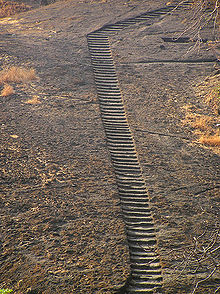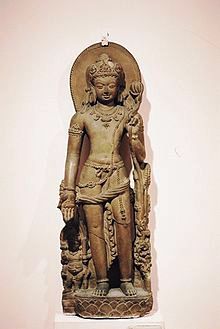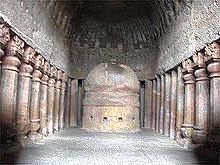Kanheri Caves- These are not simple holes in the wall
Kanheri Caves
This was during an official tour to Mumbai almost a decade back when my wife and daughter insisted to accompany me for a long requested (read ordered) tour to visit as they wanted to see the most famous city of our country. I had a meeting to attend with distributor and marketing/service staff of western region of our company that was not much of a hectic schedule so I decided to comply with the orders of my home minister. Once the meeting was over, we had two days to spare to see as much as we could which I did not consider an easy job to decide about places to visit and see in city like Mumbai. I had consulted with my regional manager to suggest a few places to visit within that short span of time that was available and the first place he suggested was Kanheri caves, the historical monuments located in a national park situated northeast of Mumbai on the hilltop of Krishnagiri. Perhaps the reason of his suggestion was influenced by the fact that we were in Borivali and the place is only 7 km away from there.
It is basically related to Buddha and his teachings in form of carvings on the rocks. We were at the national park the next morning and as we expected to see caves I mean holes in the walls type constructions, but we were told to walk and climb inside the park to find out all about the caves on our own. It had stared to drizzle a bit while we were still trying to climb up the hill through those uneven stairs. I think I was walking slower than my wife and daughter looking around the place while I heard them from top of the hill bucking me up to make it faster. I was unable to understand the reason as to what made them so excited that they could not wait for me to reach there at normal pace.
On top of the hill
 Nevertheless, once there with extra efforts for breathing I knew the reason instantly, it was all about the wonderful view of Mumbai that made them so excited that they could not help themselves from calling me to join instantly. That was really a wonderful site of Mumbai city spread over miles and miles which was looking all the more beautiful through the screen of clouds. We felt like on cloud nine although only 500 or so meters above, light drizzle still on and beyond the greenery beneath in national park, the city of Mumbai was there with its entire glorious splendor on show for us. Mumbai, where I had been so many times before but the place never looked so beautiful to me this was perhaps the angle that made all the difference. We sat there for a long time watching the painting like beauty of Mumbai and surrounding areas when the voice of my daughter brought me back to ground reality. She wanted us to move to the caves, which were right down a few steps where we were sitting. Although I wanted to sit there for little longer time but decided to see the Kanheri caves that was our main object to visit the area.
Nevertheless, once there with extra efforts for breathing I knew the reason instantly, it was all about the wonderful view of Mumbai that made them so excited that they could not help themselves from calling me to join instantly. That was really a wonderful site of Mumbai city spread over miles and miles which was looking all the more beautiful through the screen of clouds. We felt like on cloud nine although only 500 or so meters above, light drizzle still on and beyond the greenery beneath in national park, the city of Mumbai was there with its entire glorious splendor on show for us. Mumbai, where I had been so many times before but the place never looked so beautiful to me this was perhaps the angle that made all the difference. We sat there for a long time watching the painting like beauty of Mumbai and surrounding areas when the voice of my daughter brought me back to ground reality. She wanted us to move to the caves, which were right down a few steps where we were sitting. Although I wanted to sit there for little longer time but decided to see the Kanheri caves that was our main object to visit the area.
Brief description of Caves
Let me give you a brief description of the area before we move to the caves. Sanjay Gandhi national park, spread from Boriwali to Thane is an area of about two km full of greenery in Mumbai city. A unique feature in itself is that there are 109 caves cutting by basalt stone hills those hidden in between thousands of trees describe influence of Buddha religion.
Kanheri caves considered almost 2,400 years old cut out of Krishnagiri hills’ black stones by Buddhist students, are under the supervision of archeological department of India. Caves located at different sea levels these caves are considered most in numbers in one single hill. Caves are believed to developed by Buddhist monks and businessmen who used this way for going to seaports of Kalyan and Sopara through the thick forests later started cutting the caves in the hills to stay safe from wild animals. They started by cutting one big cave first that has pillars and meeting hall with a big Stupa. This stupa has another story as citizens of Mumbai taking it for Shivaling worship it giving it milk bath on Shivaratri although this is a Buddhist stupa without any doubt. Cave number 41 has a big 11 headed idol of Avalokitesvara symbol of knowledge through ten heads of Bodhtiswa that takes to the highest point of knowledge, the eleventh.
The history
These caves, which are located on different levels of the hill as these were built in stages beginning almost 2,400 years before through tenth century of Christian era as rest rooms and for safety purpose. Although you cannot compare these caves with Elephanta caves in the vicinity but this cannot take the importance and influence these caves have in Asian community especially the Buddhists as these prove the presence of Buddhist monks in western India. The main attraction the idols of Kanheri caves and pillars are believed to be influential force behind Elephanta caves. Although there are lot of empty spaces in most of the caves and the decoration that we can see today is carried out at later stages. However the increased number was the reason of increased number of caves and decoration as Buddhist monks used to pray here and need to rest that is indicative by the big long stones available in most caves.
More history

By the third century AD the influence of Buddhism showed on world and number of Buddhists increased many folds. Effects of increased number was visible on Kanheri caves also as more monks came to stay here while in transit. This prompted them to decorate caves better than ever before because even kings from different states stayed there during there visits to other neighboring states. As per the historians the caves of Elephanta and Kanheri were built almost at the same time and therefore there are many similarities in these. For instance the unfinished painting on the roof of cave number 34 of Kanheri almost matches the painting of Ajanta cave painting. By the time Mouryas and Kushans came to power the Kanheri had converted into a big learning center.
Kanheri became the big center for Buddha monks to pray and learn and also travelers stayed there during travels to different places therefore they arranged for collection of rainwater which is very much evident from the big tanks cut into stones and canals constructed to collect rainwater. The Buddhist monks came from different places like Tibet, Sumatra and Persia to Kanheri indicates the importance of the place and its value among foreigners.
The most popular cave of them all
 Cave No.3 the Choutya is the most popular cave that was built during 2nd to 6th century AD known as last Choutya of Hinayat sect of Buddhist religion. There are statues of Buddha on either sides of the cave’s gate. These two statues considered the beginning point of bigger Buddha statues at later stages that spread in entire Asia. The main hall of this cave is 28 meterx13 meter in area with 34 pillars and a stupa 5 meter high in the inner side of the cave.
Cave No.3 the Choutya is the most popular cave that was built during 2nd to 6th century AD known as last Choutya of Hinayat sect of Buddhist religion. There are statues of Buddha on either sides of the cave’s gate. These two statues considered the beginning point of bigger Buddha statues at later stages that spread in entire Asia. The main hall of this cave is 28 meterx13 meter in area with 34 pillars and a stupa 5 meter high in the inner side of the cave.
Once we went through some of the caves, my daughter wanted to go back to top of the hill back as she could see people enjoying sitting watching the beauty of the area from top of the hill. The weather was wonderful as the drizzling was still going on. However every good journey comes to an end so we decided to call it a day and came back to reach to the road where we took a rickshaw to reach to gate.
Pictures from wikipedia
Like it on Facebook, Tweet it or share this article on other bookmarking websites.
